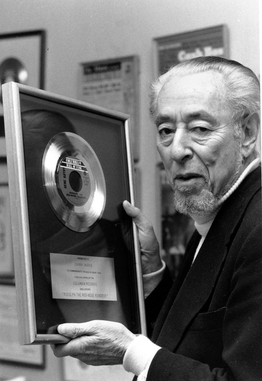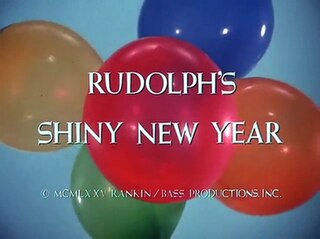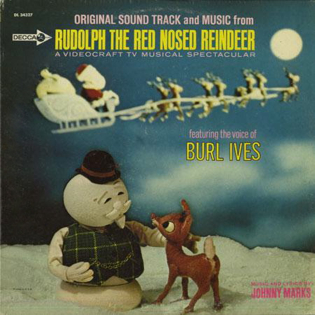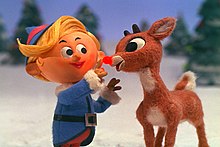
John David Marks was an American songwriter. He specialized in Christmas songs and wrote many holiday standards, including "Rudolph the Red-Nosed Reindeer", "Rockin' Around the Christmas Tree", "A Holly Jolly Christmas", "Silver and Gold", and "I Heard the Bells on Christmas Day".
Paul Robert Soles was a Canadian character actor, voice artist and television personality. He voiced the title character in Spider-Man (1967), and portrayed Hermey in the 1964 television special Rudolph the Red-Nosed Reindeer; Soles was one of the last surviving participants of the special's voice cast.

Rankin/Bass Animated Entertainment was an American production company located in New York City, and known for its seasonal television specials, usually done in stop motion animation. Rankin/Bass's stop-motion productions are recognizable by their visual style of doll-like characters with spheroid body parts and ubiquitous powdery snow using an animation technique called Animagic.

Rudolph the Red-Nosed Reindeer is a 1964 stop motion Christmas animated television special produced by Videocraft International, Ltd. and currently distributed by NBCUniversal Television Distribution. It first aired December 6, 1964, on the NBC television network in the United States and was sponsored by General Electric under the umbrella title of The General Electric Fantasy Hour. The special was based on the 1949 Johnny Marks song "Rudolph the Red-Nosed Reindeer" which was itself based on the poem of the same name written in 1939 by Marks's brother-in-law, Robert L. May. Since 1972, the special has aired on CBS. The network unveiled a high-definition, digitally remastered version of the program in 2005, re-scanned frame-by-frame from the original 35 mm film elements.

Rudolph's Shiny New Year is a 1976 Christmas and New Year's stop motion animated television special and a standalone sequel to the 1964 special Rudolph the Red-Nosed Reindeer produced by Rankin/Bass Productions. The special premiered on ABC on December 10, 1976.
Robbie the Reindeer is a trilogy of three Christmas-themed animated comedy television specials that have been produced by BBC Bristol, Absolute Digital Pictures and Comic Relief. The three television specials have also been premiered on BBC One between 1999 and 2007. The three television specials have also been distributed by BBC Studios and have also been sold to more than 30 countries. The three television specials follow the title reindeer character who travels to the North Pole to follow in his father's footsteps and join Santa Claus's reindeer sleigh team. The first television special and the second television special were animated in stop motion by the BBC Bristol animation unit and originally Aardman Animations, while the third television special was animated in computer animation by Absolute Digital Pictures. Loosely based on Rudolph the Red-Nosed Reindeer by Robert L. May, Robbie the Reindeer was created by Richard Curtis.

The Year Without a Santa Claus is a 1974 stop motion animated Christmas television special produced by Rankin/Bass Productions. The story is based on Phyllis McGinley's 1956 book of the same name. It is narrated by Shirley Booth and starring the voices of Mickey Rooney, Dick Shawn, and George S. Irving. It was originally broadcast on December 10, 1974, on ABC.

In traditional festive legend and popular culture, Santa Claus's reindeer are said to pull a sleigh through the night sky to help Santa Claus deliver gifts to children on Christmas Eve.

Santa Claus Is Comin' to Town is a 1970 American stop motion Christmas television special produced by Rankin/Bass Productions in New York, New York. The film is narrated by Fred Astaire and stars the voices of Mickey Rooney, Keenan Wynn, Robie Lester, Joan Gardner and Paul Frees, as well as an assistant song performance by the Westminster Children's Choir. The film tells the story of how Santa Claus and several Claus-related Christmas traditions came to be. It is based on the hit Christmas song, "Santa Claus Is Comin' to Town", which was written by J. Fred Coots and Haven Gillespie for Leo Feist, Inc. and introduced on radio by Eddie Cantor in 1934; and the story of Saint Nicholas.

Rudolph the Red-Nosed Reindeer and the Island of Misfit Toys is a 2001 direct-to-video animated Christmas adventure musical film directed by Bill Kowalchuk for GoodTimes Entertainment. It was released on VHS and DVD on October 30, 2001. The film takes place after the events of the original special. The film thus revisits classic characters like Yukon Cornelius, Hermey the elf, Abominable Snow Monster, and Rudolph the Red-Nosed Reindeer, who is now famous in the North Pole.

Frosty the Snowman is a 1969 American animated Christmas television special produced by Rankin/Bass Productions. It is the first television special featuring the character Frosty the Snowman. The special first aired on December 7, 1969, on the CBS television network in the United States, airing immediately after the fifth showing of A Charlie Brown Christmas; both scored high ratings. The special has aired annually for the network's Christmas and holiday season every year since.

Rudolph and Frosty's Christmas in July is an American-Japanese Christmas/Independence Day film produced by Rankin/Bass Productions, featuring characters from the company's holiday specials Rudolph the Red-Nosed Reindeer (1964) and Frosty the Snowman (1969), among others. It was filmed in Japan using the company's trademark "Animagic" stop-motion animation style. The film was originally a theatrical film released through Avco Embassy Pictures where it ran for only 2–3 weeks and was considered a box office flop. Later that year, the film premiered on television in the US on November 25, 1979, on ABC.
Robert L. May was an American retailer. He was best known for creating the fictional character Rudolph the Red-Nosed Reindeer.
"Hooves of Fire" is one of three animated BBC Christmas comedy television specials, filmed using stop motion techniques, and presented in 1999 in aid of Comic Relief.

Jack Frost is a 1979 Christmas, Winter, and Groundhog Day stop motion animated television special produced by Rankin/Bass Productions. It was directed by Jules Bass and Arthur Rankin, Jr., written by Romeo Muller, narrated by Buddy Hackett, and starring the voices of Robert Morse, Debra Clinger, and Paul Frees. The special premiered on NBC on December 13, 1979, and tells the tale of Jack Frost and his adventures as a human. It airs annually on AMC as part of its Best Christmas Ever programming block.

Pinocchio's Christmas is a 1980 Christmas stop motion television special produced by Rankin/Bass Productions that is a holiday adaptation of the 1883 novel The Adventures of Pinocchio by Carlo Collodi. The special was originally aired on ABC on December 3, 1980. It aired annually during the Christmas season on Freeform and as of 2018 airs on AMC.

A Miser Brothers’ Christmas is a 2008 Christmas stop motion spin-off special, based on the characters from the 1974 Rankin-Bass special The Year Without a Santa Claus. Distributed by Warner Bros. Animation under their Warner Premiere label and Toronto-based Cuppa Coffee Studios, the one-hour special premiered on ABC Family on Saturday, December 13, 2008, during the network's annual The 25 Days of Christmas programming.

The First Easter Rabbit is an animated Easter television special that premiered April 9, 1976 on NBC and later aired on CBS. Created by Rankin/Bass Productions, it tells the story of the Easter Bunny's origin. The special is loosely based on the 1922 children's book The Velveteen Rabbit by Margery Williams. Burl Ives narrates the special, which also features the Irving Berlin song "Easter Parade". It marked Ives's return to a Rankin/Bass special for the first time since the company's 1964 stop motion television special Rudolph the Red-Nosed Reindeer twelve years prior.

Rudolph the Red-Nosed Reindeer is a soundtrack album to the 1964 Rankin/Bass television special of the same name. The original cast recordings from the TV special are supplemented with instrumental versions recorded by the Decca Concert Orchestra on the Compact Disc version. All songs used in the television special were written by Johnny Marks.
Rudolph the Red-Nosed Reindeer is a 1948 animated short film produced and directed by Max Fleischer for Jam Handy based on the 1939 Robert L. May poem of the same name, about a flying reindeer who helps Santa Claus.
















